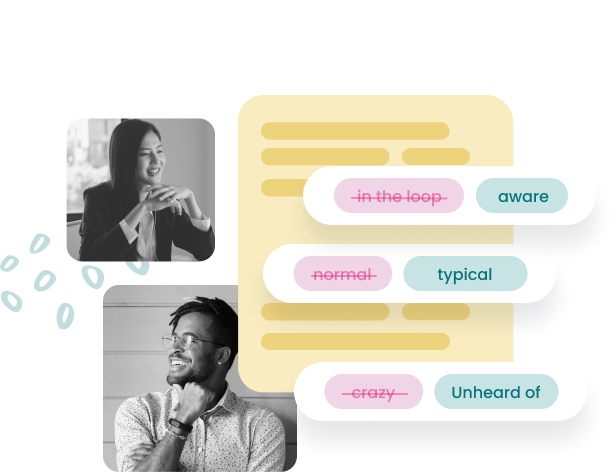Clovers attract
Job descriptions that signal “this is the job for you”
Build an equitable hiring foundation with inclusive job descriptions optimized with the leading research-based DEI language insights.
Clovers attract
Build an equitable hiring foundation with inclusive job descriptions optimized with the leading research-based DEI language insights.

See Beyond the Obvious—learn how to build a more diverse workforce. Read the eBook
Using exclusionary words or phrases can tarnish your brand and inadvertently convince talented, qualified candidates that they shouldn’t apply. Increase representation within your applicant pool by reworking job posts, emails, and social content to reflect your commitment to inclusion.
49.7 seconds is how long the average person spends reading a job description, which means every second counts. Ensure your messaging is clear, engaging, and aligned with your company’s culture and values—especially your DE&I values—to leave a great first impression.
Our scientifically researched term categories are constantly expanding.

“Unconscious bias is systemic and dramatically narrows the talent pipeline.”
— Aaron C. Kay, Ph.D., Duke University (and Clovers’ researcher)
Aaron C. Kay (PhD 2005, Stanford University) is the J Rex Fuqua Professor of Management and Professor of Psychology & Neuroscience at Duke University. His research focuses on the relation between motivation, implicit social cognition, and social issues. more
Our inclusion guidance is powered by cutting-edge academic research paired with expertise.

We used thousands of survey responses to learn which terms make candidates feel comfortable applying for jobs and which terms turn them off. Because we know that words have an impact. And that when we stick to the research (request to see it!), we empower more applicants to pursue the jobs of their dreams. Contact sales to request our research!

Artificial intelligence is subject to the bias of the humans who created it. So don’t use crowdsourcing or guesswork to build your processes, and stop scanning the web looking for trends on your own—you could be feeding your algorithms faulty data. Instead, use high quality research to build your hiring systems.

20% of employees who leave roles fault lack of job fit. Since candidates often rely on job descriptions to gauge whether they’ll find success and belonging, avoid confusion from the ground up with accurate descriptions.
Words matter. And if you want to build and source a large candidate pool, you need to use them wisely. With that in mind, we designed a free template to help you write job descriptions that are as inclusive and attractive as possible.
Job descriptions optimized with inclusive language make your brand appealing to a broader range of people.
Evaluate resumes fairly by redacting information that could trigger bias.
Understanding the skills required for your open roles will provide a clear roadmap for evaluating candidates.
Teach interviewers how to assess candidates with consistent guidelines and structured questions.
Establish a panel of diverse employees to minimize unconscious bias and monitor your hiring process.
Train your interviewers to use objective, fact-based hiring techniques.

Cathy Hogan, Education Director @ Family Centers an Education Nonprofit
To appeal to a broad range of talent, job descriptions should use inclusive language and only include a few essential job requirements.
The more requirements listed in a job description, the fewer candidates will apply. For instance, while men apply to jobs if they meet most requirements, women won’t apply unless they meet all of them. To appeal to as many candidates as possible, list less than ten qualifications and three or fewer must-haves.
Requiring “years of experience” narrows down your talent pool. You could discourage qualified candidates who have fewer years of experience, as well as great candidates who exceed your “years” goal. Avoid listing years altogether, or only list the minimum number preferred.
Subtle wording differences in job descriptions will affect who applies for the job. Using research, we’ve identified words that make candidates feel comfortable (“inclusive”) and words that turn candidates away (“problematic”). For an appealing, balanced job description, it’s important to have more inclusive terms than problematic ones.
Research shows that women are less likely to negotiate salaries, which contributes to the pay gap between men and women. When a job description includes “salary negotiable” women are able to advocate for fair compensation and help close the pay gap.
Our job description score adds points for inclusive language and subtracts points for content that will turn applicants away. A positive score indicates your job description will appeal to a large pool of diverse applicants.
Reach out to see how we can help.